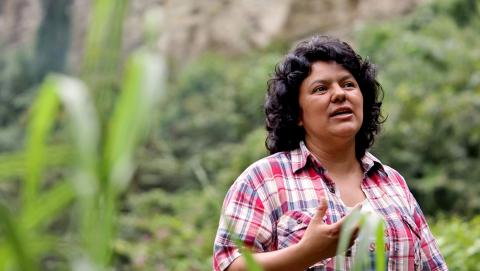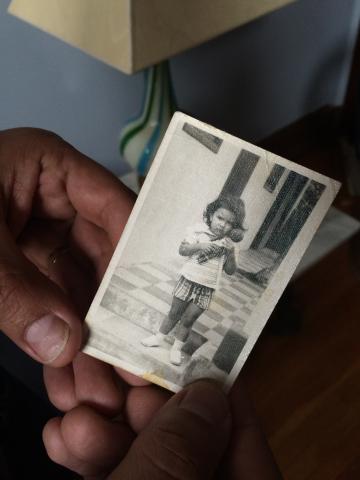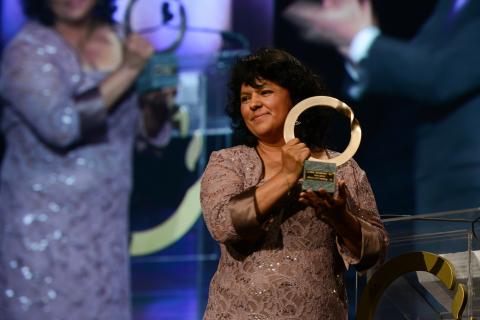Less than two weeks after the March 3 murder of acclaimed indigenous Honduran activist Berta Cáceres, Nelson García, another Honduran activist, was murdered outside his home. Both García and Cáceres were members of the Council of Popular and Indigenous Organizations of Honduras (COPINH), the indigenous rights organization Cáceres co-founded.
Though Honduran police have claimed Cáceres’ murder was the result of an attempted robbery, many believe it was a political assassination, intended to silence her. Cáceres’ family, along with more than 200 human rights organizations and now the Holy See, are calling for an independent international investigation into the crime.
“I want to express my desire that there be an independent and impartial investigation into what happened in order to resolve this horrendous crime as soon as possible,” wrote Cardinal Peter K.A. Turkson, President of the Pontifical Council for Justice and Peace, in a letter addressed to Cáceres’ family and friends.
For those closest to Cáceres, it’s a small but encouraging sign.
“It’s justifying what we’ve all been saying: that Bertita’s had a profound effect around the world,” Cáceres’ nephew, Silvio Carrillo, told Sojourners.
And, by some measures, that legacy can be found everywhere from remote villages in Honduras to papal encyclicals.
“I am vulnerable”
Berta Cáceres knew persistence was dangerous.
“Giving our lives in various ways for the protection of the rivers is giving our lives for the well-being of humanity and of this planet,” she said on April 20, 2015, after accepting the Goldman Prize for her leadership in a nonviolent campaign that pressured the world’s largest hydroelectric company to withdraw from the Agua Zarca dam on the Gualcarque River.
That same day, an international organization that monitors environmental abuse reported that Honduras is “the deadliest country in the world to defend the natural world.” According to the Global Witness report, at least 109 environmental activists were killed there between 2010 and 2015. Cáceres herself had received death threats for more than a decade, and her colleague, Tomás García, was shot by a military officer in 2013. Later that year, Cáceres told Al-Jazeera, “I take lots of care but in the end, in this country where there is total impunity I am vulnerable…when they want to kill me, they will do it.”
The deadly environment for activists is closely tied to recent Honduran history. Following the 2009 coup, in which democratically elected Honduran president Manuel Zelaya was deposed, the new government declared Honduras “open for business” and granted profitable contracts to transnational companies looking to capitalize on Honduran natural resources — including resources on indigenous land. When leaders like Cáceres demanded the rights guaranteed to indigenous people by the U.N and the International Labor Convention — including the right to determine how indigenous land is used — it wasn’t great for business. The death threats followed.
Cáceres’ words about “giving our lives” not only underscore her persistence and courage but also her deeply rooted indigenous spirituality — an understanding that the well-being of humanity depends on the well-being of the earth.
“When we started the fight for Rio Blanco, I would go into the river and I could feel what the river was telling me,” Cáceres said in 2015.
“I knew it was going to be difficult, but I also knew we were going to triumph, because the river told me so.”
2015_BertaCaceres_homepage.jpg

The spirituality of resistance
According to the Lenca creation story, when the first man began to clear land to grow maize, the trees bled and cried out against him. God then instructed the man to perform a compostura, “during which the man should sacrifice domestic animals to God and the earth to ask forgiveness for the violence he was about to do.”
Today, the Lenca people live in eastern El Salvador and western Honduras. But according to David Escobar, a Salvadoran Lenca and indigenous activist based in California, the concept of compostura remains an essential part of Lenca culture.
“‘Permission-giving’ is a common value that is still practiced today among the Lencas of Honduras and El Salvador,” he explained.
Consequently, when heavy machinery arrived on the Gualcarque River in 2011 to begin constructing a dam, without the permission of the Lenca people, the Lenca viewed it not only as the destruction of their livelihood and water supply, but also as the destruction of a sacred site and complete disregard for their indigenous rights.
So with the help of Cáceres and COPINH, the Lenca people fought back: On April 1, 2013, members of the Lenca community created a human road block to the construction site. They held out for 21 months.
As part of their defense, the Lenca people made traditional composturas, offering food and drink to the earth and asking the spirits of the earth, water, and sun for protection as they worked for justice. They also engaged the indigenous tradition of caminata, walking as a community to the dam headquarters while offering prayers or incense.
Cáceres identified these actions as a major turning point in halting construction on the Agua Zarca dam.
“In our fight to protect the Gualcarque River, the most powerful element has been the Lenca people’s spirituality and an impressive tenacity in the struggle that continues to this day,” she said.
11030.jpeg

“Forgive me!”
Shortly after Berta Cáceres was murdered, Fr. Moreno Coto, a Jesuit priest known in Honduras as “Padre Melo,” wrote a note expressing “pain and rage” at the death of someone he called a “friend” and “sister.”
“We had a particular history of close friendship and common struggle,” he said.
A few days later, with the help of Fr. Fausto Milla, a diocesan priest who was another of Cáceres’ closest allies, Padre Melo conducted Cáceres’ funeral.
Cáceres, like many Lenca people, was raised Catholic, but she herself identified most closely with the practices and beliefs of her indigenous heritage. Though Cáceres had the support of local leaders like Frs. Coto and Milla, Carrillo said his aunt had a complicated relationship with the Catholic Church.
“Certain parts of the Catholic Church have not done well by the indigenous population there,” explained Carrillo.
For Cáceres, this complicated relationship included ongoing legacy of colonization by Spanish Catholics — which, by conservative estimates, cut the indigenous population in half — as well as Cáceres’ ongoing struggle with the Honduran hierarchy. According to Cáceres, Cardinal Óscar Andrés Rodríguez instructed churchgoers not to work with COPINH or listen to radio stations that were too critical of the Honduran state. Throughout his tenure as archbishop, Cardinal Rodríguez has also been accused of endorsing the 2009 military coup by reading “a statement on national television that seemed to bless the action.” The cardinal has denied these claims.
Cardinal Rodríguez’s feelings about Cáceres seem unchanged by her murder. Carrillo told Sojourners that although someone from the apostolic nunciature in Buenos Aires — the Holy See’s embassy in Argentina — had called Cáceres’ mother, offering condolences on behalf of the pope, no one in his family had heard from the highest-ranking Catholic in Honduras.
Jenny Atlee, who has worked on human rights issues in Central America for more than three decades, confirmed that Cardinal Rodríguez had made “disparaging remarks” about Cáceres and COPINH. But Atlee also noted that the discrepancy between the hierarchy and grassroots of the church wasn’t unusual.
“There’s a real gap between those two positions … with the top levels of the Catholic church being very allied with the powers that be … and another layer of church which is more rooted in the lives and struggles of the poor and accompany those struggles and interpret and reflect on scripture from that reality,” she said.
2015_SFCeremony_Selects-1.jpg

A martyr of Laudato Si?
But when it comes to the powers that be vs. the poor, at least one person on top level of the church seem to be squarely on the side of the latter: Pope Francis.
In 2014, Cáceres met Pope Francis at the first World Meeting of Popular Movements at the Vatican. During that meeting, the pontiff assured delegates that their concerns — a desire to have “land, housing, and work” — would have a place in his then-forthcoming encyclical on the environment.
And the Holy Father delivered,
“It is essential to show special care for indigenous communities and their cultural traditions,” he wrote in the fourth chapter of Laudato Si: On Care for Our Common Home, his 2015 encyclical. He also acknowledged that “agricultural or mining projects” posed a serious threat to the survival of indigenous people.
Even the broader themes of Laudato Si sound like the interconnected worldview of indigenous spirituality that was so central to Cáceres’ work.
“A true ecological approach always becomes a social approach,” wrote Pope Francis.
“It must integrate questions of justice in debates on the environment, so as to hear both the cry of the earth and the cry of the poor.”
Following Cáceres’ death, one Italian newspaper hailed her as “a martyr of Laudato Si.” Jenny Atlee, who knew Cáceres for more than 20 years, pointed out that while that descriptor might be accurate, the Lenca woman should also be viewed as part of the “long, ongoing history of violence and genocide against indigenous people.”
Perhaps the best suggestion for how we memorialize Cáceres comes from Naomi Klein, a secular activist who was invited to discuss Laudato Si at the Vatican.
“Particularly in Latin America, with its large indigenous populations, Catholicism wasn’t able to fully displace cosmologies that centered on a living and sacred Earth, and the result was often a Church that fused Christian and indigenous world views,” she wrote in the New Yorker.
“With Laudato Si’, that fusion has finally reached the highest echelons of the Church.”
As Klein points out, the lines of influence flow from indigenous spirituality to the encyclical, not the other way around.
Or more to the point: Berta Cáceres is not a martyr in the tradition of Laudato Si. Laudato Si is an encyclical echoing what indigenous leaders like Cáceres have been saying for centuries.
Got something to say about what you're reading? We value your feedback!

